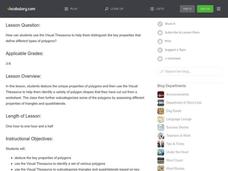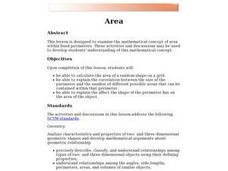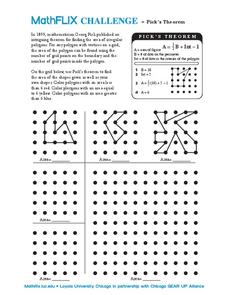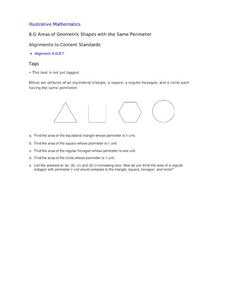Curated OER
Know Your Polygons!
Students identify and categorize different polygons. In this polygons lesson plan, students research and identify properties of polygons, identify different polygon shapes, and categorize different triangles and quadrilaterals.
Curated OER
Net "Working"
Upper elementary and middle schoolers explore the properties of various polygons. They use video, resource links, and engage in hands-on activities in order to construct geometric nets. This fine plan should lead to increased...
Curated OER
Area Applet
Elementary math classes calculate the area of a shape and explain the correlation between the size of the perimeter and the areas that can be contained within that perimeter. They also explain the effect the shape of the perimeter has on...
Curated OER
Length, Perimeter, and Area
Pupils explore the concepts of length, perimeter, and area. In this math instructional activity, students use Shape Explorer to practice finding length, perimeter, and area.
Curated OER
Finding Areas of Polygons and Circles
In this math worksheet, middle schoolers find the areas for the shapes. They apply the appropriate formula for each shape that is drawn and in the word problems.
Curated OER
A Rectangular Prism and Its Net
Identify the nets for prisms and other geometric shapes. Learners calculate the surface area of the rectangular prism then sketch the shapes of prisms and other polygons. Unfolded cereal boxes are used as a visual aid, great idea!
Curated OER
Pick's Theorem
In this Pick's Theorem worksheet, students solve and graph 6 different problems that include using Pick's Theorem to solve. First, they use Pick's Theorem to determine the area of the shapes given as well as their own shapes drawn. Then,...
Curated OER
Symmetry Using Polygons
Working on symmetry in your class? If so, this instructional activity might be for you. Learners observe different triangles and quadrilaterals, determine which are symmetrical, draw in the lines of symmetry, and color the symmetrical...
Curated OER
Finding the Area and Perimeter of Polygons
Seventh graders practice finding the area and perimeter of polygons. In this polygon area lesson, 7th graders brainstorm shapes and take a walk to locate shapes. Students record properties of shapes and use various shapes to make a...
Curated OER
Understanding Categories of Shapes
What are these shapes? Here are four shapes with some common attributes: they each have four parallel sides and four vertices. Scholars identify a rectangle, rhombus, square, and quadrilateral. Because there is an explanation written...
Curated OER
Pop-it...Stop-it
Students observe how certain geometric shapes can be used to make some structures rigid and others flexible. The activity involves construction of a 30-60 right triangle, folding while following directions, and identifying polygons.
Curated OER
Property Lists for Quadrilaterals
Students establish classifications of shapes by various properties (angles, sides, etc.). They introduce the important properties of common shapes. Students develop an awareness of the wide variety of ways the 2-D shapes can be alike.
Curated OER
Attributes of Shapes
Not all circles look the same! Expose shapes with the same name but different attributes through a matching exercise. Learners examine five shapes, matching them with a second set. For each, there is a shape bearing the same name, yet...
Curated OER
Castles On The Ground (2D & 3D Shapes)
Explore the relationship between 2D and 3D shapes by having your class view representation of shapes and investigate their symmetry. They will create a solid object from diagrams and describe the reflection or rotational symmetry. In the...
Curated OER
Perimeter of Polygons in Word Problems
Can your scholars find the perimeter of Peter's square of gold? They examine the shape and are given it's four equal side measurements in millimeters. Learners solve for the perimeter and should be reminded to include units in their...
Mathed Up!
3-D Pythagoras
Apply the Pythagorean Theorem in three-dimensional shapes. Young mathematicians watch a video that takes them through several examples of using the Pythagorean Theorem to solve problems involving lengths in three-dimensional figures. A...
Curated OER
Cutting Corners
Second graders examine two-dimensional shapes using their characteristics. In this shapes instructional activity, 2nd graders identify similarities and differences by using cut out shapes, diagrams, mirrors, and graphic organizers.
Curated OER
Investigating Tessellations in 2 Dimensions
Students analyze tessellations. In this geometry lesson, students discover which shapes can or cannot be used to create a tessellation. Students watch a video, then create their own tessellations.
Curated OER
Area of 2D Shapes Multiple Choice
In this area worksheet, students compute the area of circles, parallelograms and rectangles. This one-page worksheet contains 5 multiple-choice problems. Answers are provided in this online worksheet.
Curated OER
Areas of Geometric Shapes with the Same Perimeter
A triangle, square, hexagon, and circle all have a perimeter of one unit. Eighth graders must attempt to find the area of each and arrange them in order from least to greatest areas. A terrific task for applying four different...
Exploratorium
Building Three-Dimensional Structures
Are you looking for a good 3-D geometry lesson that includes hands-on activities for your middle schoolers? Look no further than this one! Pupils use centimeter grid paper embedded in the plan, along with detailed construction...
Curated OER
Revise Identifying 3-D Shapes pg 2
3-D shapes identification is the focus of this geometry worksheet. Students determine the name of eight different 3-D shapes. Answers appear at the end of the worksheet.
Curated OER
Explore Three-Dimensional Shapes
Students are assigned to shape groups and explore three-dimensional shapes. They review math skills and two-dimensional shapes.
Curated OER
Shapes and Angles
Are your geometry whizzes learning about angles and shapes? This online worksheet gives 10 multiple choice questions based on images and word problems. Concepts include deducting angle degree, classifying shapes, and identifying angle...























